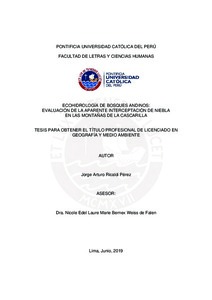| dc.contributor.advisor | Bernex Weiss de Falen, Nicole Edel Laure Marie | |
| dc.contributor.author | Ricaldi Pérez, Jorge Arturo | |
| dc.date.accessioned | 2019-07-18T22:00:46Z | es_ES |
| dc.date.available | 2019-07-18T22:00:46Z | es_ES |
| dc.date.created | 2019 | es_ES |
| dc.date.issued | 2019-07-18 | es_ES |
| dc.identifier.uri | http://hdl.handle.net/20.500.12404/14605 | |
| dc.description.abstract | El objetivo de esta investigación es caracterizar los parámetros específicos de la relación bosqueniebla
y los componentes metodológicos espaciales y temporales para estimar la contribución
del agua de niebla por interceptación en el bosque andino de las Montañas de La Cascarilla. Los
bosques montanos tropicales con niebla frecuente (TMCF, por sus siglas en inglés)
son ecosistemas de gran valor ecohidrológico ya que aumentan las entradas de agua al
interceptar las gotas de las corrientes de aire. Debido a que muchas de sus
características están relacionadas con la formación de nubes es posible plantear el
análisis hidrometeorológico regional y la exploración florística para evaluar zonas de TMCF.
Así, se opta por el método del balance de precipitaciones bajo la premisa de que el agua de
niebla que alcanza el suelo del bosque debe encontrarse como la diferencia entre la
precipitación de lluvia a cielo abierto y el agua que escurre dentro del dosel. Además, se opta
por restringir el período de captación a la estación húmeda debido a mejores condiciones para
detectar entradas de niebla hacia los flujos en el suelo de bosque. Para la recolección de datos
se instala dos estaciones y se acondicionan los instrumentos y los protocolos de registro con
el fin de que los participantes locales puedan acceder a gestionar las estaciones. Luego,
en el análisis de los resultados se emplea herramientas SIG para corroborar las
condiciones hidrometeorológicas regionales durante la captación de datos y el análisis de
dispersión y correspondencia. De esta forma, se determina la asociación entre los registros de
los neblinómetros y los pluviómetros con las oscilaciones del clima y observaciones de
rutina. Los resultados muestran que hay días de registros que responden a la hipótesis
principal sobre entradas de agua de niebla que aumentan la caída respecto a la lluvia bruta.
De esta manera el bosque califica como un TMCF. | es_ES |
| dc.description.abstract | The objective of this research is to characterize the specific parameters of the forest-fog
relationship and the spatial and temporal methodological components to estimate the contribution
of fog water by interception in the Andean forest of the La Cascarilla Mountains. Tropical montane
cloud forests (TMCF) are ecosystems of a high ecohydrological value since it increases water
inputs by intercepting the droplets of air currents. Because many of its characteristics are related
to the formation of clouds, it is possible to propose regional hydrometeorological analysis and
floristic exploration to evaluate areas of TMCF. Thus, the rainfall balance method is chosen under
the premise that the fog water that reaches the forest floor must be found as the difference
between the rainfall in the open sky and the water that drains into the canopy. In addition, it is
decided to restrict the field data collection period to the humid season due to better conditions to
detect fog entries towards flows in the forest floor. For field data collection two stations are
installed and the instruments and registration protocols are conditioned so that local stakeholders
can access to manage the stations. Then, in the results analysis, GIS tools are used to
corroborate the regional hydro meteorological conditions during field data collection and
dispersion and correspondence analysis. In this way, the association between the records of the
fog gauges and the rain gauges with the climate oscillations and routine observations is
determined. The results show that there are days of records that respond to the main hypothesis
about fog water entries that increase the drop compared to the gross rainfall. In this way the forest
qualifies as a TMCF. | es_ES |
| dc.language.iso | spa | es_ES |
| dc.publisher | Pontificia Universidad Católica del Perú | es_ES |
| dc.rights | info:eu-repo/semantics/closedAccess | es_ES |
| dc.subject | Ecohidrología | es_ES |
| dc.subject | Bosques--Perú | es_ES |
| dc.title | Ecohidrología de bosques andinos: evaluación de la aparente interceptación de niebla en las montañas de la cascarilla | es_ES |
| dc.type | info:eu-repo/semantics/bachelorThesis | es_ES |
| thesis.degree.name | Licenciado en Geografía y Medio Ambiente | es_ES |
| thesis.degree.level | Título Profesional | es_ES |
| thesis.degree.grantor | Pontificia Universidad Católica del Perú. Facultad de Letras y Ciencias Humanas | es_ES |
| thesis.degree.discipline | Geografía y Medio Ambiente | es_ES |
| renati.advisor.dni | 06098390 | |
| renati.advisor.orcid | https://orcid.org/0000-0002-6508-049X | es_ES |
| renati.discipline | 532036 | es_ES |
| renati.level | https://purl.org/pe-repo/renati/level#tituloProfesional | es_ES |
| renati.type | http://purl.org/pe-repo/renati/type#tesis | es_ES |
| dc.publisher.country | PE | es_ES |
| dc.subject.ocde | https://purl.org/pe-repo/ocde/ford#5.07.00 | es_ES |





